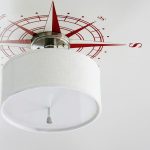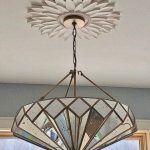5 Tips for Choosing the Right Ceiling Medallion for Your Home
A ceiling medallion makes an amazing accent for a diverse range of ceiling lighting types, from ceiling fans to chandeliers. At its basic, a ceiling medallion is an ornamental piece that glams-up and improves the surrounding areas around the roof canopy, where the wiring of a chandelier or other light fixture enters the junction box of the ceiling.
These medallions come in a range of finishes and sizes and can be also painted on to match the present room decor. Opt for a medallion size that perfectly fits the light fixtures along with the style and size of the room where it will be placed.
When choosing a ceiling medallion, keep in mind the 5 following pointers:
1. Size of the Ceiling and Room
Calculate the room’s dimensions to decide what size of a medallion would ideally fir space. With the help of a measuring tape, measure both the width and length of the room then multiply both the figures and divide by 7 to estimate the medallion’s size in inches. Also, take into consideration the ceiling’s height. Higher focal rooms and ceilings can be improved with bigger medallions that would otherwise overwhelm a tiny space.
2. Style and Size of the Ceiling Fan
Choose a medallion that ideally fits the size as well as complements the ceiling fan’s style. Medallions should be either larger or smaller than the light fixture – not the foundation but the fixture itself. Matching the medallion’s size to that of the light fixture’s will visually compress the room’s size. Since ceilings fans have a larger radius, you should choose a medallion with a smaller diameter than the fan.
3. To Paint or Not to Paint?
You can match your trim using a nice glossy paint or you can just go for an accent color. A majority of ceiling medallions are purchased primed and ready for paint. The final answer will, of course, depends on your preferences and the present decor of your room. It is always a good idea to get inspired first and then make a final decision, so make sure to look up ideas on the internet.
4. Element About the Position? Center It
If you love the idea of owning a medallion but are unsure of where to put it, go for the center position. Symmetry is aesthetically pleasing, and accenting the center point can help tie the room together, especially when it comes to larger spaces.
In order to determine the center of a rectangular room, calculate the length of one of the shorter walls. Determine the wall’s center point and mark it. Do the same for the adjacent wall. Now use a laser plumb or chalk to draw a line between the two points. Continue the process using the focal points of the longer walls. The point where the two lines meet is the center of the room.
5. Take into Consideration the Ceiling Fixtures
When thinking about where to locate a visual feature on the floor, it can be easy to overlook the ceiling’s features. These will impact how you actually perceive the floor. Swag lamps, ceiling fans, and chandeliers tend to draw the eye up and down from their spot. You may put the ceiling medallion in the heart of a room, but if your chandelier is not perfectly centered as well, that variance will give the impression of a misplaced medallion. To correct this issue, try aligning the medallion with the focal point of the fixture, using a plumb line for accuracy.
On the other hand, if you decide to not place the medallion in the center, make sure that it at least looks deliberate. A ceiling medallion that is just partially off from the visual center of a room will look weird and like a mistake. However, if it is pretty clear that it was never intended to be placed in the heart of the room, the asymmetry won’t be as distracting. The secret is to create visual harmony, meaning that the parts should fit with the entire room in a way that each element appears to be in its right place.






































